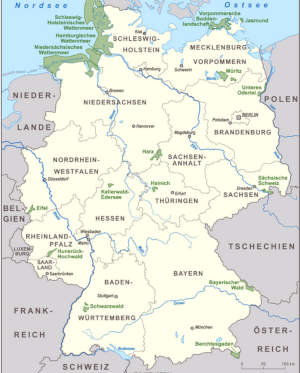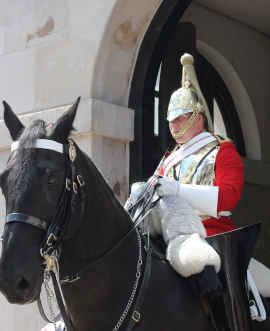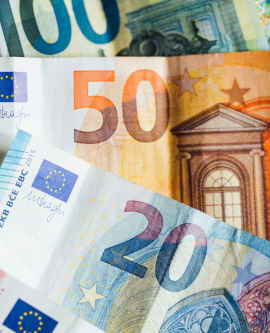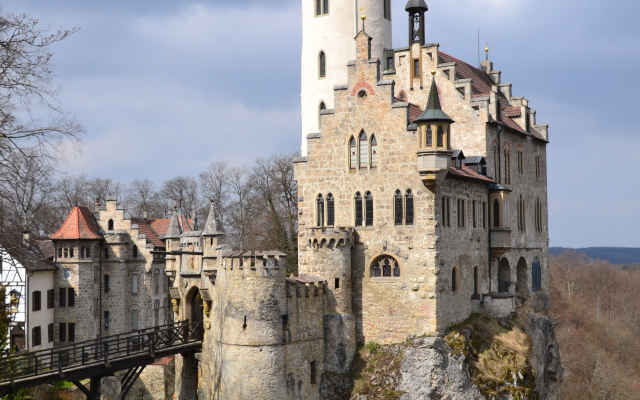This delightful nonfiction book expounds on the history of this central European country, from pre-Roman Empire times to 2017 and the AfD. Although crammed with facts, the author does take time out to include piquant observations such as the tomb of Theodoric the Great looking like an “apprentice classical architect’s contribution to the Maginot Line” (and that’s exactly what it looks like!)
I’m going to briefly summarize what this book is about; but unlike the book, I’ll be using modern-day place names throughout, such as France rather than Gaul, as France was known in ancient times.
The barbarian times — before the Romans came
In this period, beginning around 500 BC, tribes in northern Europe were just beginning to differentiate themselves linguistically. Clustered around what is now Germany, Denmark, and Sweden, these barbarian tribes had no concept of farming, marketplaces, libraries, theaters, elections, or written history back in the day. The “Germans” weren’t even called Germans then. (Indeed it wasn’t until fairly late in history that Germany emerged as a unified political entity.)
The Roman Empire kept expanding outward into countries like the present-day France. From there, the next natural step would be to cross the Rhine and start collecting taxes; but the whole region was considered too uncivilized to make it worth their while. And any conquering force would have to pass through the dense forests on the other side of the river, along narrow paths just perfect for an ambush.

Julius Caesar through the fall of Rome
Caesar’s armies finally did conquer a large swath of what is now Germany bounded roughly by the rivers Rhine, Main, Danube, and Elbe, covering the present-day German states of Nordheim-Westfallen, Wiedersachsen, and northern Bayern (Bavaria). Areas to the west of the Rhine were already under Roman control, and the mysterious lands to the east of the Elbe river, with its ferocious Slavs, were still considered too dangerous to enter.
The Elbe River has long been a line of demarcation in Germany. A great cultural divide exists between lands west of the Elbe and lands to the east, a theme which keeps asserting itself all throughout German history.
In its heyday, the Roman Empire conquered just about everything it laid its eyes upon. But for one reason or another, the Romans lost the will to keep it all going. The fall of Rome has been traditionally blamed on invaders from the north (meaning Germans), but according to the author, “the lights were going out in Europe long before the Germans got to the switch”.
The middle ages
With Rome no longer in control of Europe, power shifted to the north, to whomever could conquer. When Pepin claimed the throne, his lack of a connection to a royal dynasty of old created a problem — a lack of legitimacy. The solution was a partnership between Church and State, where the Pope would bless the new monarch, and receive lands and other earthly goods in exchange. This, of course, set the pattern for the entire medieval period. Pepin’s empire grew to include all of northern Europe, although again stopping at the Elbe.
This empire was presented as the successor to the ancient Roman one. However, a system of electing the next German King was eventually put in place. This was not a democracy in the modern sense, because he was chosen by a small group of nobles called prince-electors, who grew very rich on the inevitable bribes. Often, a new King would ascend to the throne deeply in debt, who would then have to start a war of extraction to be able to clear his debts.
At this point, Germany was finally on its way to becoming a distinct nation, ruled by a German King in a German city. Its influence was even starting to extend east of the Elbe River. Yet in Germany, most of the actual power remained in the hands of the local nobles, leading to a patchwork of semi-independent staes coming under the influence of various foreign powers at different times. It would still be centuries before Germany would be truly unified.

Prussia and Martin Luther through the end of World War 1
Prussia (Pruscie) had been a minor state, roughly centered between modern Gdansk and Riga. Considered to be a rogue state, Emperor Fredrick II gave the Teutonic Knights the right to rule there if they could conquer it. This they did. Its officer class, who became known as the Junkers (“young lords”), retained an outsized influenced in the affairs of the new nation — in Voltaire’s words “other states have armies; in Prussia, the army has a state”.
(Note: despite the similar names, there is no connection between Russia and Prussia, just like there is no connection between New York and Newark.)
While Prussia was consolidating itself, Martin Luther was kicking off the Protestant Reformation with his 95 theses. Religious issues aside, what is significant here is that his influence in Germany was concentrated mostly between the Elbe and Oder Rivers. This area, roughly including the states of Mecklenburg-Vorpommern, Brandenburg, Berlin, Sachsen, Sachsen-Anhalt, and Thuringen, or what would later become East Germany, again sets this region apart from the rest of Germany; mainly Protestant in a country that is otherwise mainly Catholic.
The next few centuries saw the balance of power shifting back and forth by wars and threats of wars. Plots and schemes were hatched in an attempt to gain allies to help fight the next conflict, or at least keep potential allies of other countries neutral enough not to help their enemies.
In the course of time, two new players were added to the European squabbling, England and Russia. Both these countries were powerful enough to check German expansion.
By the 20th century, Prussia was in full control over Germany, the Prussian army was in full control over Prussia, and the Junkers (Prussian army officer class) were in full control over the Prussian army. It was just not possible for a non-Junker to become head-of-state; Kaiser Wilhelm II of Germany was also the King of Prussia.
The Junkers came to believe their own rhetoric about their invincibility. And they believed that Prussia-Germany could not survive unless both England and Russia were defeated. So when Archduke Franz Ferdinand of Austria-Hungary was assasinated in Sarajevo, kicking off World War 1, Prussia-Germany used this as cover to invade Russia. They assumed that the Anglo-Saxons (western democracies) would not enter the war, that they lacked the ability and readiness to fight. But enter the war they did, and Prussia-Germany ended up fighting on two fronts. This schizoid strategy was a major reason why they lost.
The Weimar Republic through the Cold War
The Junkers pulled a disappearing act when surrender terms were imposed upon Germany, leaving the civilian government to take the blame. And take the blame they did, with enormous reparation debts and other terms. Debts had to be repaid in hard currency; the only way this could be done was by printing oodles of Reichmarks, which led to hyperinflation. Millions of middle-class Germans, who saved their money over years, lost it all. Even so, Germany was struggling to keep up with their burdens, when the Great Depression of 1929 caused vital lines of credit to dry up. This impeded any attempts at recovery and radicalized German politics. The Junkers, used to being treated as a privileged upper class, became just another political faction fighting for power and influence at the ballot box.
On the political spectrum, the Junkers’ far right German National Peoples’ Party (DNVP) joined with the new even farther right Nazi party. Together, they were able to take over the government and install Adolf Hitler as Chancellor.
And what part of Germany provided his main source of support? This book answers that question. (Hint: it wasn’t Munich.)
Immediately after taking office as Chancellor, he demanded and received an Enabling Act, declaring a state of emergency and allowing him to act without the Reichtag’s (legislature’s) approval. This was the beginning of the German dictatorship.
The author does not go into the details of Word War 2 much; those details having been much written about elsewhere. A major milestone in this war was when the American and Soviet armies linked up — where else — at the Elbe River, which (more or less) became the dividing line between West and East Germany. Per the author: “East Germany didn’t become different because of the Russian occupation of 1945-1989; the Russians occupied the place because it had always been different”.
The Soviet Union turned their part of Germany into a worker’s paradise, and then had to build fortifications to keep their people from escaping it. In the meantime, West German Chancellor Konrad Adenauer sought closer ties with the West, willing to forget about the East Germans as one would try to forget a bad dream. The United States played a key role in cementing those ties, through the transfer of American culture and military assistance in the form of NATO.
However you may choose to explain it, the Soviet Union ended in 1991, and all of its “accomplishments” just faded away. A year before, in 1990, Germany, through an executive order issued by then Chancellor Helmut Kohl the former East Germany was absorbed into the former West Germany. The grateful former East Germans supported Kohl politically in return.

Germany Reunited
Germany since 1990 has continued to be an economic powerhouse: stable, technologically advanced, and export-driven. Weaker European Union (EU) states looked to Germany when they needed help; they stepped to help Greece with their debt crisis; even though the price of that help has been a painful austerity program. Germany has adopted the Euro as its unit of currency, weathered the financial meltdown of 2008 without too much pain, and elected its first female Chancellor (Kanzlerin), Angela Merkel.
Although Merkel has been well-respected, many have criticized her “let them all in” policy towards refugees; the Alternative for Germany (AfD) party has gained traction over this issue.
Berlin has pumped trillions of Euros to support and modernize the former East German states; yet they still lag behind the rest of the country economically. And they continue to be radicalized: the National Party of Germany (NPD), an extreme right-wing party, formed in 1964, enjoyed a brief surge in popularity there in the 2010’s, but are fading into obscurity again.
Hawes’ conclusion at the end of the book was that Germany, east of the Elbe river, has been given disproportionate weight in politics for over 100 years. And that it’s time for Germany to take a more balanced approach to its future.

The shortest summary of The Shortest History! This is excellent, Jennifer. Thank you. I was particularly struck by how much geography plays a role in the history—those rivers determined so much.